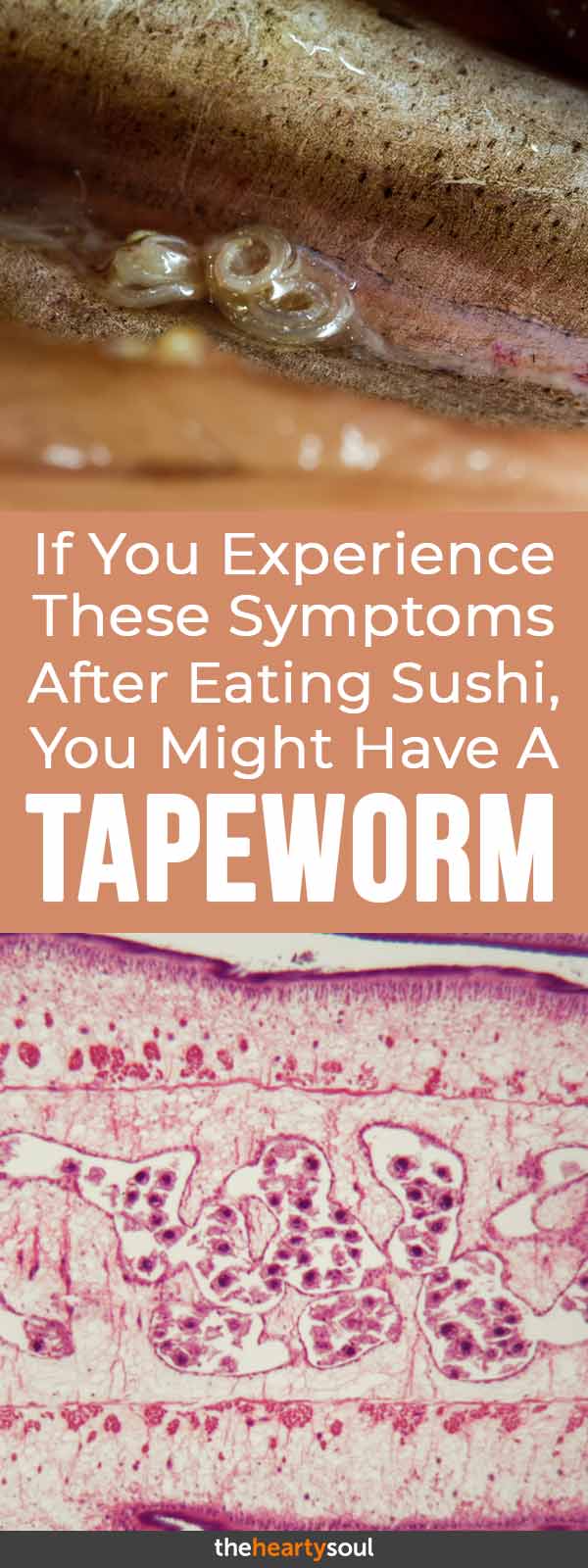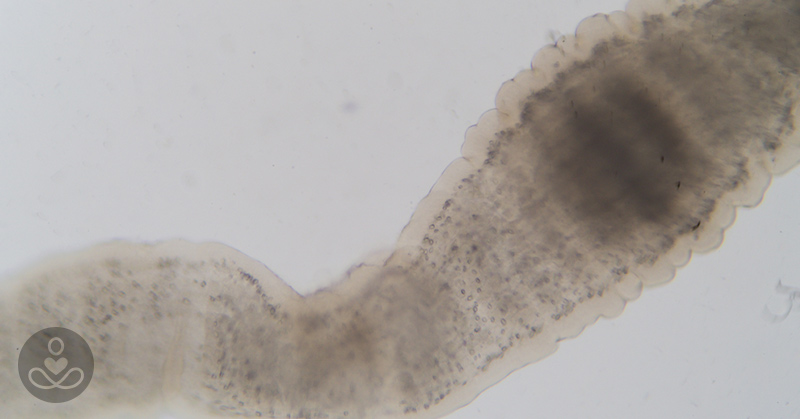Dr. Kenny Banh of Community Regional Medical Center in Fresno, California, has seen his fair share of remarkable things in the emergency room. But when a patient walked in with a tapeworm of over 5 feet in length this past August, it was enough to make Banh stop in his tracks!
Banh described in an interview with WebMD,
“I have seen tapeworms and intestinal infections. For me, that’s the largest I’ve seen. The one that is the Guinness World Record is 30-feet-long. The truth is, intestinal parasites are common in impoverished, third-world countries where they don’t have a lot of clean drinking water. It’s super-less common in America.”
So where did this massive tapeworm come from? Banh’s patient was a self-professed “sushi devotee”, so it was no surprise to the doctor that he’d picked up the parasite in his food. The patient had passed the tapeworm at home, and understandably alarmed, wrapped it around a toilet paper roll and brought it to the emergency room to be inspected. Measuring in at 5 foot 6, the tapeworm was actually as tall as Dr. Banh!
“It’s pretty hard because sushi is actually flash frozen in the U.S. That actually kills off the (tapeworm) larvae. So the biggest thing is just be aware of the food-handling of the restaurant you’re eating in. It doesn’t matter if it’s sushi, vegetables, cooked meat. All those things have risks. The proper handling is the main thing. I don’t know that I’d eat sushi out of a food truck, for example.” Banh said.
Am I At Risk of Tapeworms If I Eat Fish?
According to a study published in the Journal of Clinical Microbiology, approximately twenty million people are believed to have tapeworms.[1] Do you know what a tapeworm is? If you do, you hopefully have never had to personally experience one. But it looks like you’re going to have to be extra cautious the next time you choose to buy salmon.
Scientists have confirmed that the Diphyllobothrium latum – also known as the Japanese broad tapeworm – has made its way into fish in America by way of the Asian Pacific. This 32-year old Portuguese man who landed in the hospital after a sushi dinner learned this the hard way.
The Japanese Broad Tapeworm in Sushi
After enjoying a sushi dinner, as many of us in North America like to do, a 32-year old Portuguese man was rushed to the emergency room with severe stomach and intestine pain, vomiting, and a fever, according to a new 2017 case study.
The doctors performed an endoscopy when they found out he had eaten sushi for dinner. After looking into his stomach with the camera, sure enough they discovered larvae from the Anisakis fish parasite embedded into his swollen and inflamed stomach lining. Once the larvae were removed using a special net, the man’s symptoms went away. [9]
What Is the Japanese Broad Tapeworm?
A tapeworm is a parasitic flatworm which can live in humans’ and other mammals’ intestines. Their bodies are ribbonlike with a small head that has hooks and suckers coming from it. They survive on whatever their hosts consume which, in humans, often results in severe weight loss. Tapeworms can also segment themselves so that a big tapeworm can split into many smaller independent tapeworms.[2]
Specifically, the Japanese broad tapeworm can grow as long as thirty feet. The Centers for Disease Control and Prevention (CDC) put together a thorough diagram outlining a tapeworm’s life cycle.[3] (View it for a clearer understanding of how they form and eventually infect.)
Tapeworm Symptoms and Signs of Infection
While most infections show or produce no symptoms, there are some to keep an eye out for in yourself or others in severe cases.[4]
- Abdominal discomfort
- Diarrhea
- Vomiting
- Weight loss
- Vitamin B12 deficiency (potential for anemia)
- Intestinal obstruction
- Gall bladder disease
The Japanese Broad Tapeworm in America
In 2009, Clinical Microbiology Reviews published a study that called our attention to increasing popularity of eating uncooked and raw fish. The study noted that uninspected imports of Pacific pink salmon could lead to a rapid and massive increase in Diphyllobothrium infections.[5] While the latest study is small, it seems to pick up where that one left off.
Roman Kuchta, working out of the Czech Academy of Sciences, is the lead researcher heading up the most recent study published in CDC’s Emerging Infectious Diseases.
To date, there have been approximately two-thousand reported cases of the Japanese broad tapeworm infection. In relation to the human population, this figure is very small according to Kuchta who added that most of these reports are based in northeastern Asia.[6]
However, people in the U.S. may be more concerned now because the researchers have found the tapeworm in wild pink salmon from the Alaskan Pacific.
Kuchta and his team analyzed five species of wild salmon from local Alaskan coast fishermen, totaling sixty-four fish. While studying the twenty-three Pink salmon, they found samples that contained larvae from the Japanese broad tapeworm. The footage below shows a live tapeworm from one of their salmon samples.
The tapeworm infection, says Kuchta, tends not to be dangerous in that only about twenty percent of infected people suffer effects such as diarrhea and abdominal pain.
Ultimately, the study aims “to alert parasitologists and medical doctors about the potential danger of human infection with this long tapeworm resulting from consumption of infected salmon imported (on ice) from the Pacific coast of North America and elsewhere.”[7]
Ways to Lower Your Risk
Current research and the apparent minimal risk may not be enough to keep people from eating their salmon or raw fish. Amesh Adalja, a spokesman for the Infectious Diseases Society of America agrees that “the risk of contracting the tapeworm from your sushi is low – but it exists.”[8] But for those who don’t wish to risk it, you’d benefit from avoiding undercooked or raw fish.
Here’s a tip if you don’t want to waste the raw fish you do have or just can’t give it up. Freeze the fish for a few days.[8] This will ideally kill the Japanese broad tapeworm and other parasites.
To kill parasites including tapeworms, the FDA recommends cooking fish to an internal temperature of at least 145° F (~63° C). If you aren’t cooking your fish yet, you can try three freezing methods:[4]
- -4°F (-20°C) or below for 7 days (total time)
- -31°F (-35°C) or below until solid, and storing at -31°F (-35°C) or below for 15 hours
- -31°F (-35°C) or below until solid and storing at -4°F (-20°C) or below for 24 hours
To kill larvae, you only need to cook fish at 55C for 5 minutes, and when following the above freezing guidelines, be sure that your fish is cut no thicker than 15cm. [10]
Of course, you can’t control how the fish is stored or prepared at a restaurant, so make sure to check up on the health and safety compliance and rating of your restaurant before you go. You can find the food codes for each state here, though to find out the health and safety status of restaurants in your area you may have to look up individual states or cities.
In Canada, you can find the food inspection reports for each city (sorted first by province) here. No matter if you are eating out or at home, if you suspect any type of food poisoning or food borne illness, see your doctor immediately.

Sources
- [1] https://jcm.asm.org/content/53/4/1355.full
- [2] https://www.merriam-webster.com/dictionary/tapeworm
- [3] https://www.cdc.gov/parasites/diphyllobothrium/biology.html
- [4] https://www.cdc.gov/parasites/diphyllobothrium/faqs.html
- [5] https://www.ncbi.nlm.nih.gov/pmc/articles/PMC2620636/
- [6] https://wwwnc.cdc.gov/eid/article/23/2/16-1026_article#r1
- [7] https://www.foodsafetynews.com/2017/01/researchers-find-dangerous-tapeworms-in-alaskan-salmon/#.WIdmVRsrLIU
- [8] https://www.webmd.com/food-recipes/food-poisoning/news/20170112/sushi-lovers-beware-tapeworm-now-found-in-us-salmon#1
- [10] https://www.ncbi.nlm.nih.gov/pmc/articles/PMC3374688/

